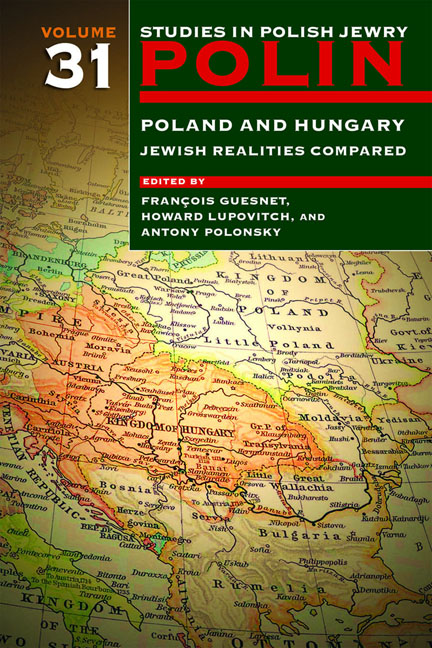Book contents
- Frontmatter
- Dedication
- Editors and Advisers
- Preface
- Polin
- Polin: Studies in Polish Jewry
- Contents
- Note on Place Names
- Note on Transliteration
- Part I POLAND AND HUNGARY: JEWISH REALITIES COMPARED
- JEWISH ACCULTURATION AND INTEGRATION
- JEWISH RELIGIOUS LIFE
- JEWS IN POPULAR CULTURE
- THE INTERWAR YEARS
- THE HOLOCAUST AND ITS AFTERMATH
- PERSONAL REFLECTIONS
- Part II NEW VIEWS
- Part III OBITUARIES
- Notes on the Contributors
- Index
Abnormal Times: Intersectionality and Anti-Jewish Violence in Hungary and Poland, 1918–1922
- Frontmatter
- Dedication
- Editors and Advisers
- Preface
- Polin
- Polin: Studies in Polish Jewry
- Contents
- Note on Place Names
- Note on Transliteration
- Part I POLAND AND HUNGARY: JEWISH REALITIES COMPARED
- JEWISH ACCULTURATION AND INTEGRATION
- JEWISH RELIGIOUS LIFE
- JEWS IN POPULAR CULTURE
- THE INTERWAR YEARS
- THE HOLOCAUST AND ITS AFTERMATH
- PERSONAL REFLECTIONS
- Part II NEW VIEWS
- Part III OBITUARIES
- Notes on the Contributors
- Index
Summary
THE END of the First World War in eastern Europe could hardly be said to have inaugurated a period of peace. Marked by revolutions, counter-revolutions, renewed foreign warfare, and military occupations, the early post-armistice statebuilding processes were violent affairs, as political factions wrestled for dominance over their political, ethnic, and religious enemies, and armies battled for territory. This extended period of conflict and violence in the region could be described as the ‘long First World War’. The conflicts that shaped it traced their short-term roots to the preceding years of open warfare and the revolutions that occurred in the wake of the defeat of the Central Powers.
In the last decade or so historians of the eastern front have used the long First World War as a framework to conceptualize the continuation of warfare and the political crises it unleashed long after the last shots were fired on the western front. The concept also highlights how the violence, repression, and deprivation experienced by many people at the time, especially those who were particularly vulnerable, such as the working classes, Jews, and those involved in leftist political movements, represented a radical break from ‘normal’ life or ‘normal’ conditions. The fighting had devastated Jewish communities in the Russian Pale of Settlement and in historical Polish territories. The damage to towns and villages and the displacement of hundreds of thousands of people had eroded or destroyed the religious and economic life of many communities. Following the armistice, revolutionary and counter-revolutionary forces further menaced Jewish communities, who were blamed by empowered nationalists for both defeat and revolution. A report on pogroms in Poland stated: ‘The war is not yet at an end for the Jewish people, who continue to live in panic here.’ In short, the war and its afterlife were abnormal, deviant, an interruption of normal life.
The idea that normal times had been suspended permeated reports on the situation in both Poland and Hungary. This is, perhaps, less surprising in the case of Poland, a state reconstructed from the fragments of three empires that had been a war zone for five years.
- Type
- Chapter
- Information
- Polin: Studies in Polish Jewry Volume 31Poland and Hungary: Jewish Realities Compared, pp. 313 - 328Publisher: Liverpool University PressPrint publication year: 2018



